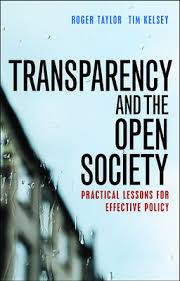Book review | Transparency and the Open Society, by Roger Taylor and Tim Kelsey
In Transparency and the Open Society: Practical Lessons for Effective Policy, Roger Taylor and Tim Kelsey offers a systematic framework for establishing greater transparency across government, and civil society more broadly. While the book does raise a number of further questions about the capacity to engender a more transparent society, Andrew Reid recommends it to those seeking a better understanding of the mechanisms through which governments and other institutions can be held to account.

Photo: luscofusco via a CC-BY-NC 2.0 licence
Transparency and the Open Society: Practical Lessons for Effective Policy. Roger Taylor and Tim Kelsey. Polity, 2016
The public is increasingly presented with a range of information that is designed to help them make meaningful choices about the public services they use. As the quantity of data that is stored grows, so does the problem of knowing what to do with it. The ethical debate around privacy and the right to control information is playing out alongside technological developments that provide an opportunity to subvert old norms relating to confidentiality and disclosure.
All this makes the lack of a systematic account of what it is to be a transparent government slightly surprising. Transparency and the Open Society: Practical Lessons for Effective Policy is therefore nothing if not timely. The book adopts a simple definition of transparency as the ability to discern whether government institutions have acted fairly during a particular decision-making process. It then considers a range of different ways in which transparency of this kind has been pursued and undermined across a range of polities. Finally it offers some brief, general suggestions for how the government, citizens and civil society actors might bring about a more transparent society.
The authors, Roger Taylor and Tim Kelsey, have both worked at the intersection of public institutions, NGOs and private companies in initiatives to foster transparency in government, especially healthcare. Most notably, they were co-founders of ‘Dr Foster’, an organisation committed to providing the public with information about healthcare, including producing an annual guide to British hospitals. In 2006 the company was involved in a (somewhat controversial) joint venture with the Department of Health to provide information to enhance patient choice. For better and worse, Taylor and Kelsey’s experiences as vanguardists for transparency and interlocutors with public institutions shape this book. They are, perhaps unsurprisingly, optimistic about the prospects for rendering public institutions more transparent and the benefits of this.
Transparency and the Open Society is split into two parts. The second, longer section considers the impact of various types of legal mechanism and civic action meant to enhance the transparency of government, building towards recommendations for the future. It also contains a useful discussion of how different kinds of data have been used by political organisations. This methodical recent history of transparency is broken up by brief summaries of case studies from around the world. The use of these examples, combined with short chapters, makes what could otherwise be quite a dry read about policy-making much easier to digest. The writing is also clear, although the authors do occasionally slip into jargon: the transparency regimes they describe are split into transparency 0.0, 1.0, 2.0 and 3.0 like iterations of a computer program.
The shorter, first part of the book lays out a theoretical framework for understanding transparency such that ‘the transparency of any organisation, authority or decision-making process is the degree to which someone affected by it can evidence whether or not it is treating them fairly’ (65). Subsequent pages emphasise that it is the transparency of decision-making processes that we ought to be most concerned with. The purpose of transparency is, by this account, to enable people to establish whether certain rules are being adhered to by the institutional systems that affect their lives.
This broad definition underpins more controversial claims. Perhaps most strikingly, given that this is a book that explicitly deals with the issues raised by ‘big data’, the view of transparency endorsed by the authors is essentially a relational one. They frequently reiterate that increasing transparency is not about increasing the quantity of information available. Instead, transparency depends upon an equitable distribution of knowledge between citizens and governments. The persistent worry is not so much a lack of data, but rather information that is presented in an edited or selective fashion. A practical policy suggestion that arises from this is the idea that a greater degree of information ought to be available in unmediated, ‘granular’ form. Where granular data cannot be made available, or where it needs to be processed before it can be meaningful to the wider public, civil society organisations should play a prominent role.
Though this account of transparency is in many ways convincing, it occasionally suffers because the question of what it is to be treated fairly under a system of rules is never fully addressed. This is partly because of a belief that the terms through which outcomes are assessed can be fairly defined through a transparent procedure. Whilst the fact that neither of the authors is a political or legal philosopher is played up as a strength in the foreword, in this area a more systematic appraisal of both the obligations connected with, and the legal basis of, transparency would be welcome. This is something the authors, to their credit, acknowledge. The theoretical chapters would also certainly benefit from greater engagement with ongoing legal and philosophical discussions around publicity, which is the idea that justice must be conducted in a way that is visible to the wider public.
The authors argue that greater transparency requires increasing the leverage for citizens to influence government, and that a more equal political voice is therefore constitutive of transparency. This requires that dissemination of information and mechanisms for political change be structured in a way that is ‘complementary’ (108). Again, civil society organisations are central to enabling this relationship. How convincing a reader finds this, and the work as a whole, will probably depend on whether they share the authors’ ‘belief – the faith perhaps – that within every society there is some minimal point of leverage upon which information can work’ (102). There is no doubt the suggestions offered about the storage and dissemination of data would raise public awareness on certain issues, but it is not necessarily true that this will reinforce the potential for meaningful public scrutiny.
The broad policy suggestions at the end of the book involve a complex interaction between different actors in society. That these are grounded in a realistic account of how institutions and groups compete and co-exist is an undoubted strength. However, the optimistic view of a more transparent state in the future – transparency 3.0 – relies upon relevant parties observing certain behavioural norms. The absence of an account of when we have obligations to adhere to these norms is therefore a problem. For example, the authors argue that disclosure of information ought not be total, but at a level that is ‘reasonable’ and ‘fair’ (63); yet this just defers a debate about what reasonable disclosure of information entails.
There are many readers who will find Transparency and the Open Society a useful complement to their own interests or work, and it is worth reading for anyone wanting to get a better understanding of the mechanisms by which we hold our government to account. It is undoubtedly an informative and challenging book, but one that raises a number of questions. It clearly lays out information that is pertinent to existing debates in politics, ethics, law and the wider social sciences, but it does not transcend these.
This post represents the views of the author and not those of Democratic Audit. It was first published at the LSE Review of Books.
Andrew Reid is a PhD candidate in the Politics department at the University of Leicester. His research interests are in political theory, particularly debates around public justification, democratic theory and political rights. You can contact Andrew at ar362@leicester.ac.uk.

 Find this book:
Find this book: 



 Democratic Audit's core funding is provided by the Joseph Rowntree Charitable Trust. Additional funding is provided by the London School of Economics.
Democratic Audit's core funding is provided by the Joseph Rowntree Charitable Trust. Additional funding is provided by the London School of Economics.
The idea of parties behaving according to behavioral norms in regard to transparency is simply hope without any shred of evidence that it is possible unless you care to define behavioral norms in very elastic and therefore pointless ways.
When I was an elected member of the London Assembly, you would think I would have had the right to hold the Mayor to account (that’s what it says i was there to do, in the expensive brochures showing smiling people grinning at the Tower of London).
Well I (and of course my other fellow members) were barred from any and all the documents enabling us to do the job – and therefore if we wanted information all we could do was issue a torrent of Freedom of Information requests, most of which were frustrated, slowed down, ignored. Anything current was therefore impossible to get unless you were the Mayor’s own party and basically therefore only used the info to support his or her case.
And of course with everything being oput into private hands, we were denied anything about these on the outrageous grounds of commercial confidentiality. Spending public money and those holding to account barred from access! Extraordinary. What a wheeze. Thank you Labour 1997-2010.
And here is the rub – all information is political and can be used to advance or oppose a position (some say ‘distorted’ but the better word is just ‘used’)…so the ‘norm’ is to hide everything you possibly can in every possible way at all times, even down to the colour of the conference room chairs.
Start with that, and you do not need graphs and theories and models – just a robust commitment to transparency, laws that oblige certain things to be made available as a matter of course, and within a short space of time, an end to restricting freedom of information on spurious grounds of ‘time wasting’ (the more you hear that the more you know you are on to something) and a dramatic restriction of the ‘commercial confidentiality’ excuse to hide corruption and graft. Everything is now commercial to some degree.
When I, as a former publisher, was barred as an elected representative from knowing the basic elements of the shady dealings involved in the production by City Hall of a staggeringly expensive London-wide ‘newspaper’ a decade ago, which I could have produced and delivered for a tenth of the cost and with more revenue, something is very seriously wrong. It has got worse not better.